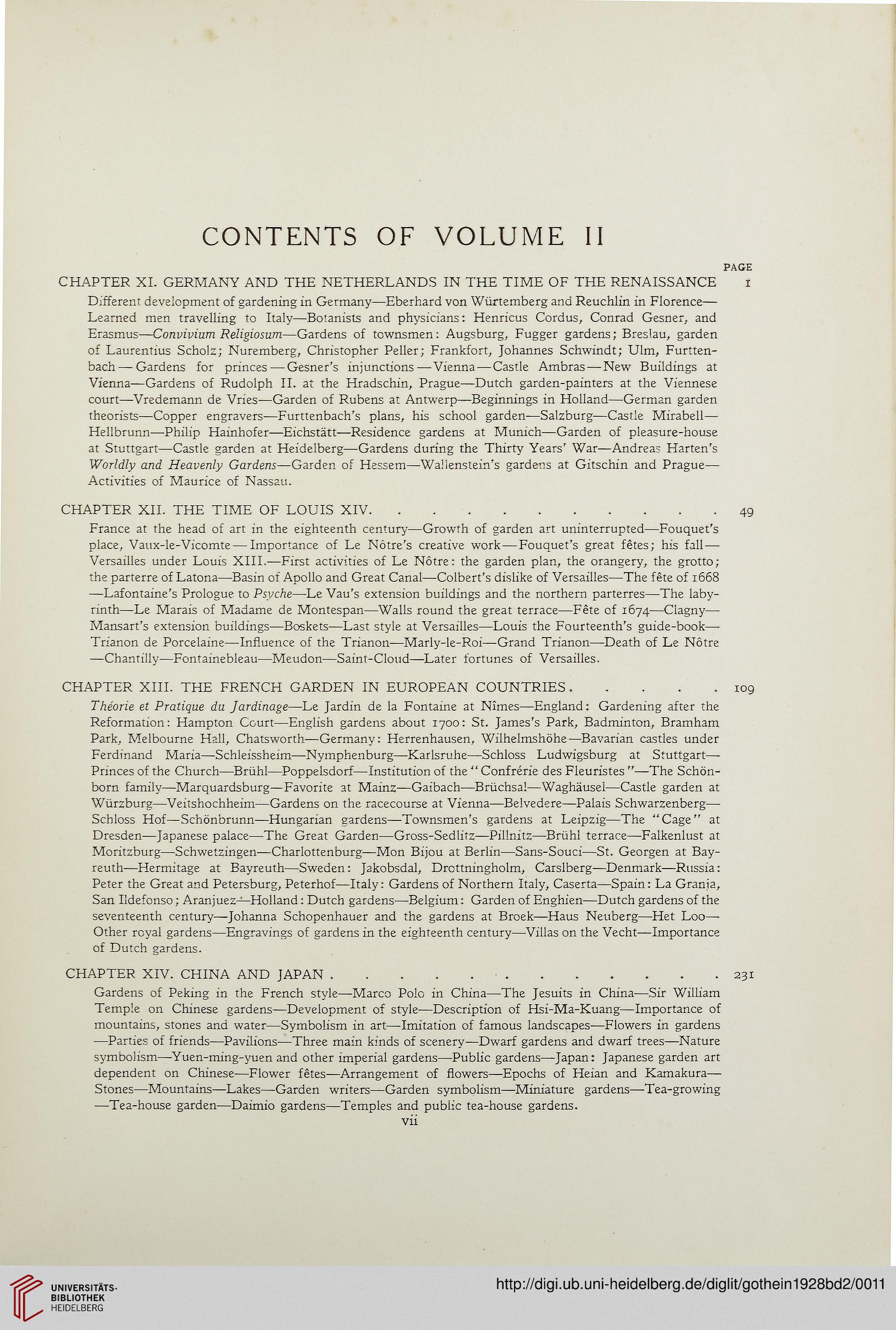CONTENTS OF VOLUME II
PAGE
CHAPTER XL GERMANY AND THE NETHERLANDS IN THE TIME OF THE RENAISSANCE i
Different development of gardening in Germany—Eberhard von Wiirtemberg and Reuchlin in Florence—
Learned men travelling to Italy—Botanists and physicians: Henricus Cordus, Conrad Gesner. and
Erasmus—Convivium Religiosum—Gardens of townsmen: Augsburg, Fugger gardens; Breslau, garden
of Laurentius Scholz; Nuremberg, Christopher Peller; Frankfort, Johannes Schwindt; Ulm, Furtten-
bach — Gardens for princes — Gesner's injunctions—-Vienna—Castle Ambras — New Buildings at
Vienna—Gardens of Rudolph IL at the Hradschin, Prague—Dutch garden-painters at the Viennese
court—Vredemann de Vries—Garden of Rubens at Antwerp—Beginnings in Holland—German garden
theorists—Copper engravers—Furttenbach's plans, his school garden—Salzburg—Castle Mirabell—
Hellbrunn—Philip Hainhofer—Eichstatt—Residence gardens at Munich—Garden of pleasure-house
at Stuttgart—Castle garden at Heidelberg—Gardens during the Thirty Years' War—Andrea? Harten's
Worldly and Heavenly Gardens—Garden of Hessem—Walienstein's gardens at Gitschin and Prague—
Activities of Maurice of Nassau.
CHAPTER XII. THE TIME OF LOUIS XIV. . . ■........49
France at the head of art in the eighteenth century—Growth of garden art uninterrupted—Fouquet's
place, Vaux-le-Vicomte—Importance of Le Notre's creative work — Fouquet's great fetes; his fall —
Versailles under Louis XIII.—First activities of Le Notre: the garden plan, the orangery, the grotto;
the parterre of Latona—Basin of Apollo and Great Canal—Colbert's dislike of Versailles—The fete of 1668
—Lafontaine's Prologue to Psyche—Le Vau's extension buildings and the northern parterres—The laby-
rinth—Le Marais of Madame de Montespan—Walls round the great terrace—Fete of 1674—Clagny—
Mansart's extension buildings—Boskets—Last style at Versailles—Louis the Fourteenth's guide-book—
Trianon de Porcelaine—Influence of the Trianon—Marly-le-Roi—Grand Trianon—Death of Le Notre
—Chantilly—Fontainebleau—Meudon—Saint-Cloud—Later fortunes of Versailles.
CHAPTER XIII. THE FRENCH GARDEN IN EUROPEAN COUNTRIES.....109
Theorie et Pratique du Jardinage—Le Jardin de la Fontaine at Nimes—England: Gardening after the
Reformation: Hampton Court—English gardens about 1700: St. James's Park, Badminton, Bramham
Park, Melbourne Hall, Chatsworth—Germany: Herrenhausen, Wilhelmshohe—Bavarian castles under
Ferdinand Maria—Schleissheim—Nymphenburg—Karlsruhe—Schloss Ludwigsburg at Stuttgart—
Princes of the Church—Briihl—Poppelsdorf—Institution of the " Confrerie des Fleuristes "—The Schon-
born family—Marquardsburg—Favorite at Mainz—Gaibach—Briichsal—Waghausei—Castle garden at
Wiirzburg—Veitshochheim—Gardens on the racecourse at Vienna—Belvedere—Palais Schwarzenberg—
Schloss Hof—Schonbrunn—Hungarian gardens—Townsmen's gardens at Leipzig—The "Cage" at
Dresden—Japanese palace—The Great Garden—Gross-Sedlitz—Pillnitz—Briihl terrace—Falkenlust at
Moritzburg—Schwetzingen—Charlottenburg—Mon Bijou at Berlin—Sans-Souci—St. Georgen at Bay-
reuth—Hermitage at Bayreuth—Sweden: Jakobsdal, Drcttningholm, Carslberg—Denmark—Russia:
Peter the Great and Petersburg, Peterhof—Italy: Gardens of Northern Italy, Caserta—Spain: La Grania,
San Ildefonso; Aranjuez—Holland: Dutch gardens—Belgium: Garden of Enghien—Dutch gardens of the
seventeenth century—Johanna Schopenhauer and the gardens at Broek—Haus Neuberg—Het Loo—■
Other royal gardens—Engravings of gardens in the eighteenth century—Villas on the Vecht—-Importance
of Dutch gardens.
CHAPTER XIV. CHINA AND JAPAN............231
Gardens of Peking in the French style—Marco Polo in China—The Jesuits in China—Sir William
Temple on Chinese gardens—Development of style—Description of Hsi-Ma-Kuang—Importance of
mountains, stones and water—Symbolism in art—Imitation of famous landscapes—Flowers in gardens
—Parties of friends—Pavilions—Three main kinds of scenery—Dwarf gardens and dwarf trees—Nature
symbolism—Yuen-ming-yuen and other imperial gardens—Public gardens—Japan: Japanese garden art
dependent on Chinese—Flower fetes—Arrangement of flowers—Epochs of Heian and Kamakura—
Stones—Mountains—Lakes—Garden writers—Garden symbolism—Miniature gardens—Tea-growing
—Tea-house garden—Daimio gardens—Temples and public tea-house gardens.
vii
PAGE
CHAPTER XL GERMANY AND THE NETHERLANDS IN THE TIME OF THE RENAISSANCE i
Different development of gardening in Germany—Eberhard von Wiirtemberg and Reuchlin in Florence—
Learned men travelling to Italy—Botanists and physicians: Henricus Cordus, Conrad Gesner. and
Erasmus—Convivium Religiosum—Gardens of townsmen: Augsburg, Fugger gardens; Breslau, garden
of Laurentius Scholz; Nuremberg, Christopher Peller; Frankfort, Johannes Schwindt; Ulm, Furtten-
bach — Gardens for princes — Gesner's injunctions—-Vienna—Castle Ambras — New Buildings at
Vienna—Gardens of Rudolph IL at the Hradschin, Prague—Dutch garden-painters at the Viennese
court—Vredemann de Vries—Garden of Rubens at Antwerp—Beginnings in Holland—German garden
theorists—Copper engravers—Furttenbach's plans, his school garden—Salzburg—Castle Mirabell—
Hellbrunn—Philip Hainhofer—Eichstatt—Residence gardens at Munich—Garden of pleasure-house
at Stuttgart—Castle garden at Heidelberg—Gardens during the Thirty Years' War—Andrea? Harten's
Worldly and Heavenly Gardens—Garden of Hessem—Walienstein's gardens at Gitschin and Prague—
Activities of Maurice of Nassau.
CHAPTER XII. THE TIME OF LOUIS XIV. . . ■........49
France at the head of art in the eighteenth century—Growth of garden art uninterrupted—Fouquet's
place, Vaux-le-Vicomte—Importance of Le Notre's creative work — Fouquet's great fetes; his fall —
Versailles under Louis XIII.—First activities of Le Notre: the garden plan, the orangery, the grotto;
the parterre of Latona—Basin of Apollo and Great Canal—Colbert's dislike of Versailles—The fete of 1668
—Lafontaine's Prologue to Psyche—Le Vau's extension buildings and the northern parterres—The laby-
rinth—Le Marais of Madame de Montespan—Walls round the great terrace—Fete of 1674—Clagny—
Mansart's extension buildings—Boskets—Last style at Versailles—Louis the Fourteenth's guide-book—
Trianon de Porcelaine—Influence of the Trianon—Marly-le-Roi—Grand Trianon—Death of Le Notre
—Chantilly—Fontainebleau—Meudon—Saint-Cloud—Later fortunes of Versailles.
CHAPTER XIII. THE FRENCH GARDEN IN EUROPEAN COUNTRIES.....109
Theorie et Pratique du Jardinage—Le Jardin de la Fontaine at Nimes—England: Gardening after the
Reformation: Hampton Court—English gardens about 1700: St. James's Park, Badminton, Bramham
Park, Melbourne Hall, Chatsworth—Germany: Herrenhausen, Wilhelmshohe—Bavarian castles under
Ferdinand Maria—Schleissheim—Nymphenburg—Karlsruhe—Schloss Ludwigsburg at Stuttgart—
Princes of the Church—Briihl—Poppelsdorf—Institution of the " Confrerie des Fleuristes "—The Schon-
born family—Marquardsburg—Favorite at Mainz—Gaibach—Briichsal—Waghausei—Castle garden at
Wiirzburg—Veitshochheim—Gardens on the racecourse at Vienna—Belvedere—Palais Schwarzenberg—
Schloss Hof—Schonbrunn—Hungarian gardens—Townsmen's gardens at Leipzig—The "Cage" at
Dresden—Japanese palace—The Great Garden—Gross-Sedlitz—Pillnitz—Briihl terrace—Falkenlust at
Moritzburg—Schwetzingen—Charlottenburg—Mon Bijou at Berlin—Sans-Souci—St. Georgen at Bay-
reuth—Hermitage at Bayreuth—Sweden: Jakobsdal, Drcttningholm, Carslberg—Denmark—Russia:
Peter the Great and Petersburg, Peterhof—Italy: Gardens of Northern Italy, Caserta—Spain: La Grania,
San Ildefonso; Aranjuez—Holland: Dutch gardens—Belgium: Garden of Enghien—Dutch gardens of the
seventeenth century—Johanna Schopenhauer and the gardens at Broek—Haus Neuberg—Het Loo—■
Other royal gardens—Engravings of gardens in the eighteenth century—Villas on the Vecht—-Importance
of Dutch gardens.
CHAPTER XIV. CHINA AND JAPAN............231
Gardens of Peking in the French style—Marco Polo in China—The Jesuits in China—Sir William
Temple on Chinese gardens—Development of style—Description of Hsi-Ma-Kuang—Importance of
mountains, stones and water—Symbolism in art—Imitation of famous landscapes—Flowers in gardens
—Parties of friends—Pavilions—Three main kinds of scenery—Dwarf gardens and dwarf trees—Nature
symbolism—Yuen-ming-yuen and other imperial gardens—Public gardens—Japan: Japanese garden art
dependent on Chinese—Flower fetes—Arrangement of flowers—Epochs of Heian and Kamakura—
Stones—Mountains—Lakes—Garden writers—Garden symbolism—Miniature gardens—Tea-growing
—Tea-house garden—Daimio gardens—Temples and public tea-house gardens.
vii





